The Giant Sequoia Mortician
Sam Prentice, a District Hydrologist for the USDA Forest Service.
As wildfires become more common and powerful, the Giant Sequoias of the American West are burning at alarming rates. These enormous beings stand at a few hundred feet in height and a hundred feet in diameter. Due to climate change and 100 years of human mismanagement, the forests where these Sequoias live are being lost to wildfire.
In this episode, Kris sits down with Sam Prentice, a District Hydrologist for the USDA Forest Service, to speak about how wildfires are impacting our Giant Sequoia groves, the surrounding communities, and what we can do about it.
Sam stands at the base of a Giant Sequoia.
This episode also dives into the history of fire management, or mismanagement, in the United States, and how current government bodies and nonprofits are not on the same page for a mitigation plan.
MORE PHOTOS FROM SAM:
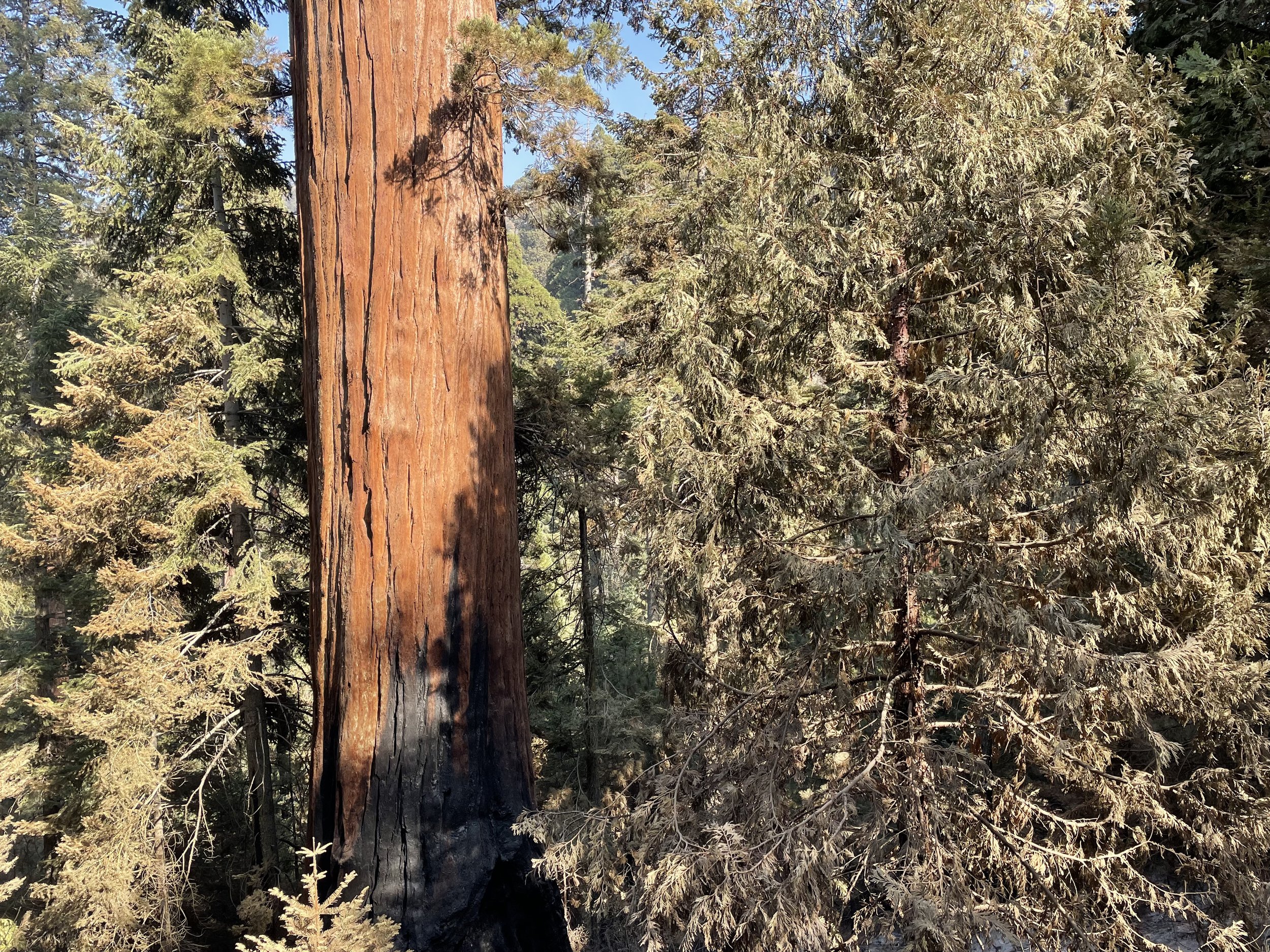
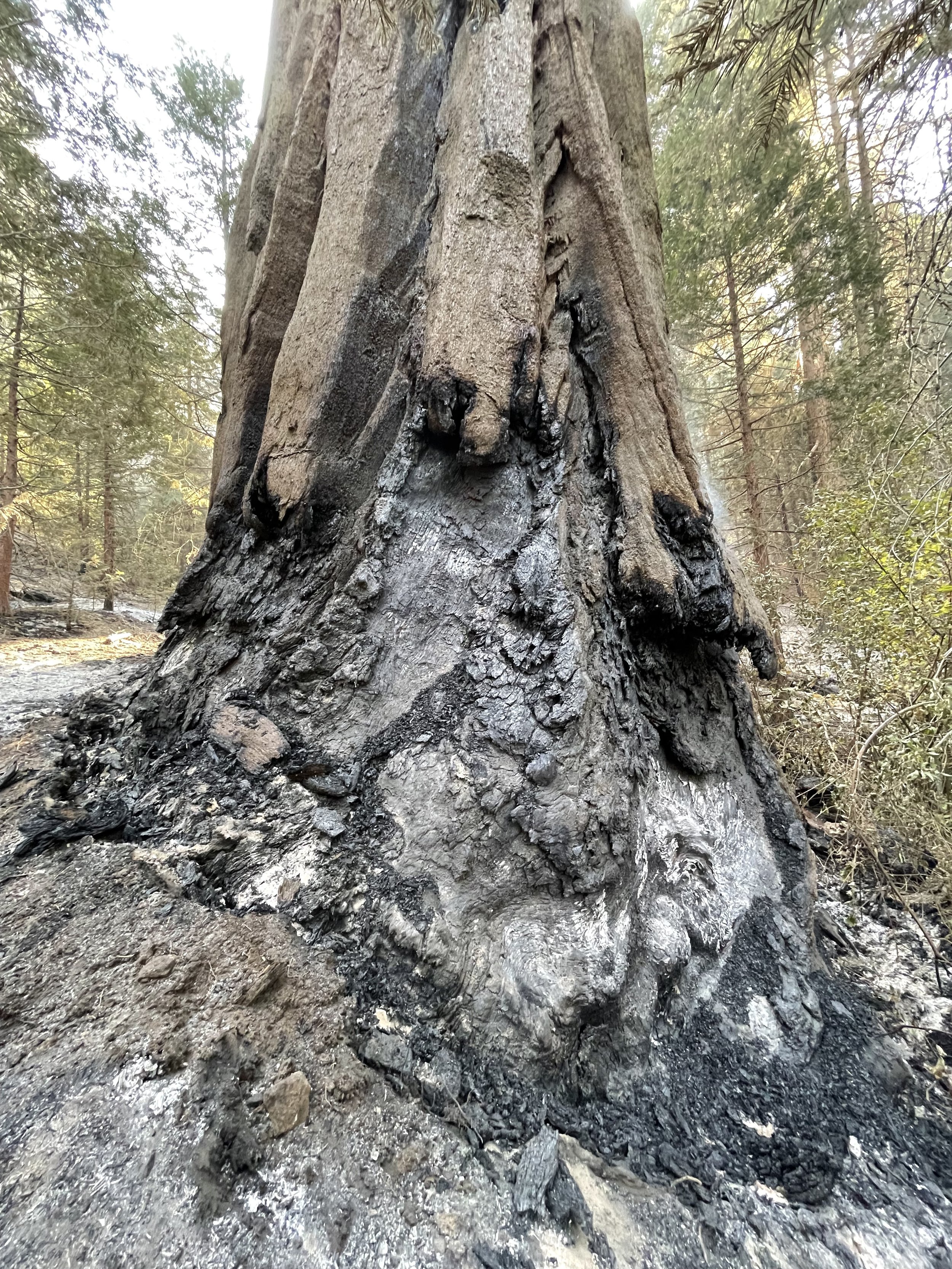
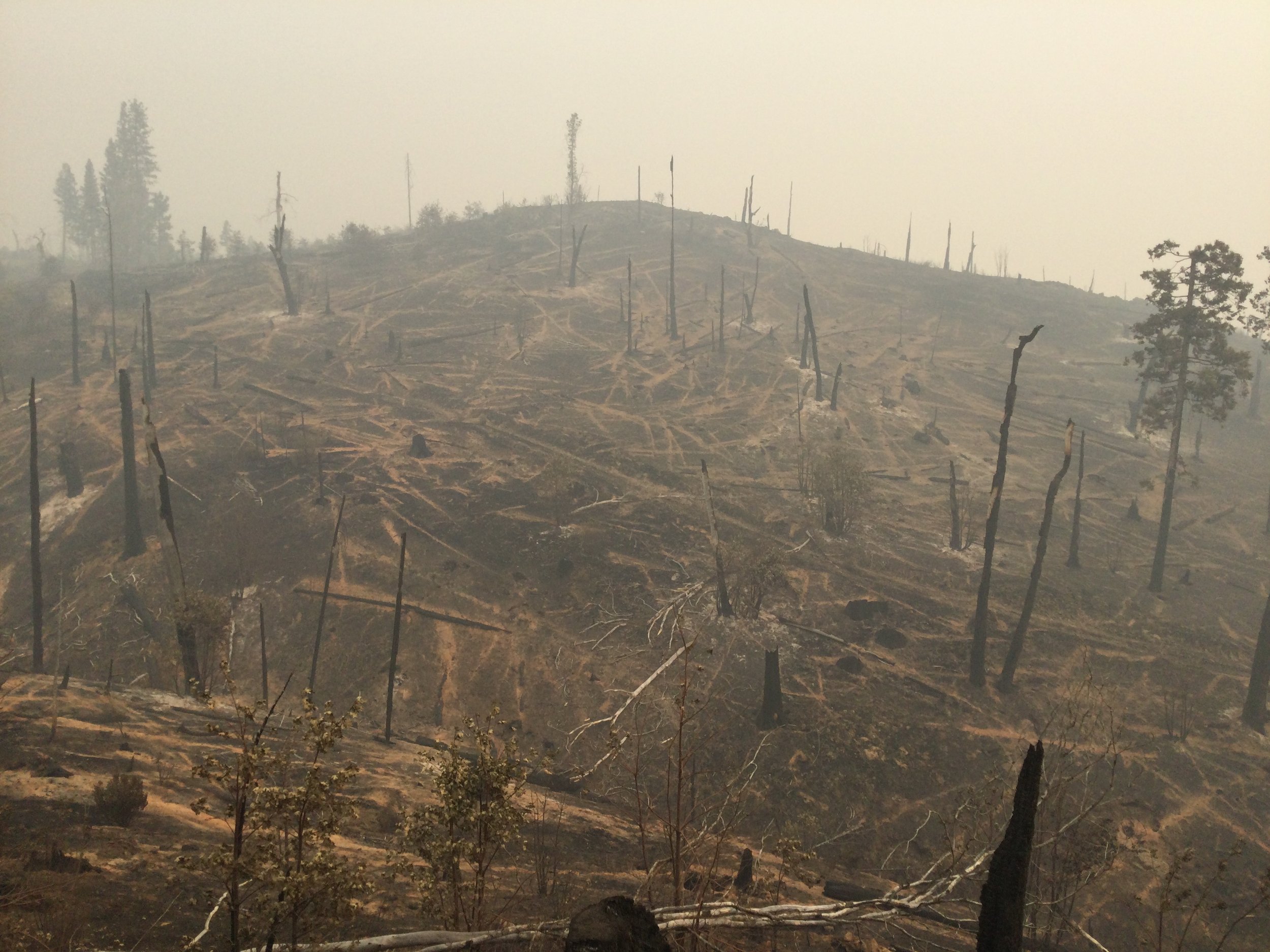
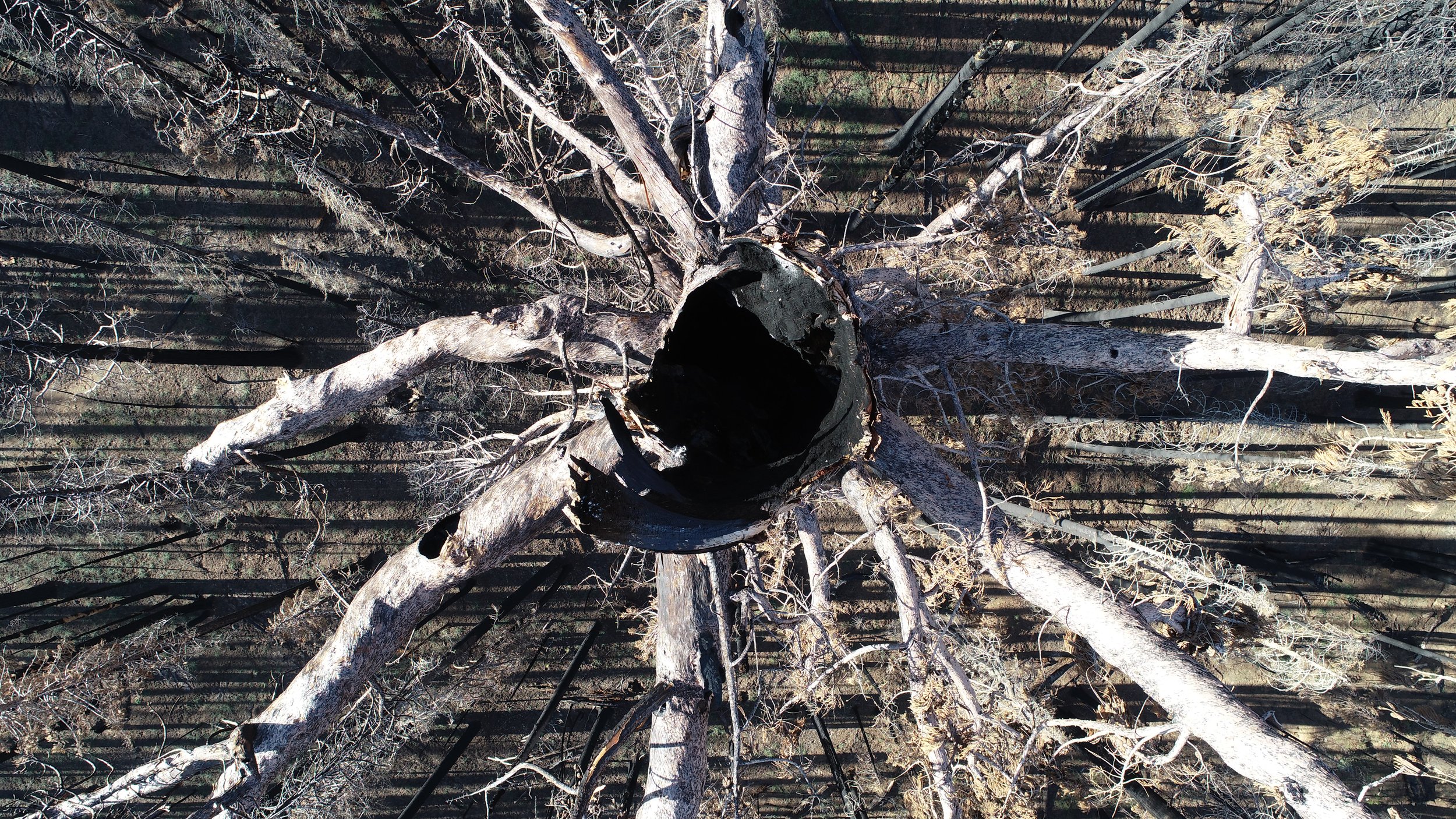
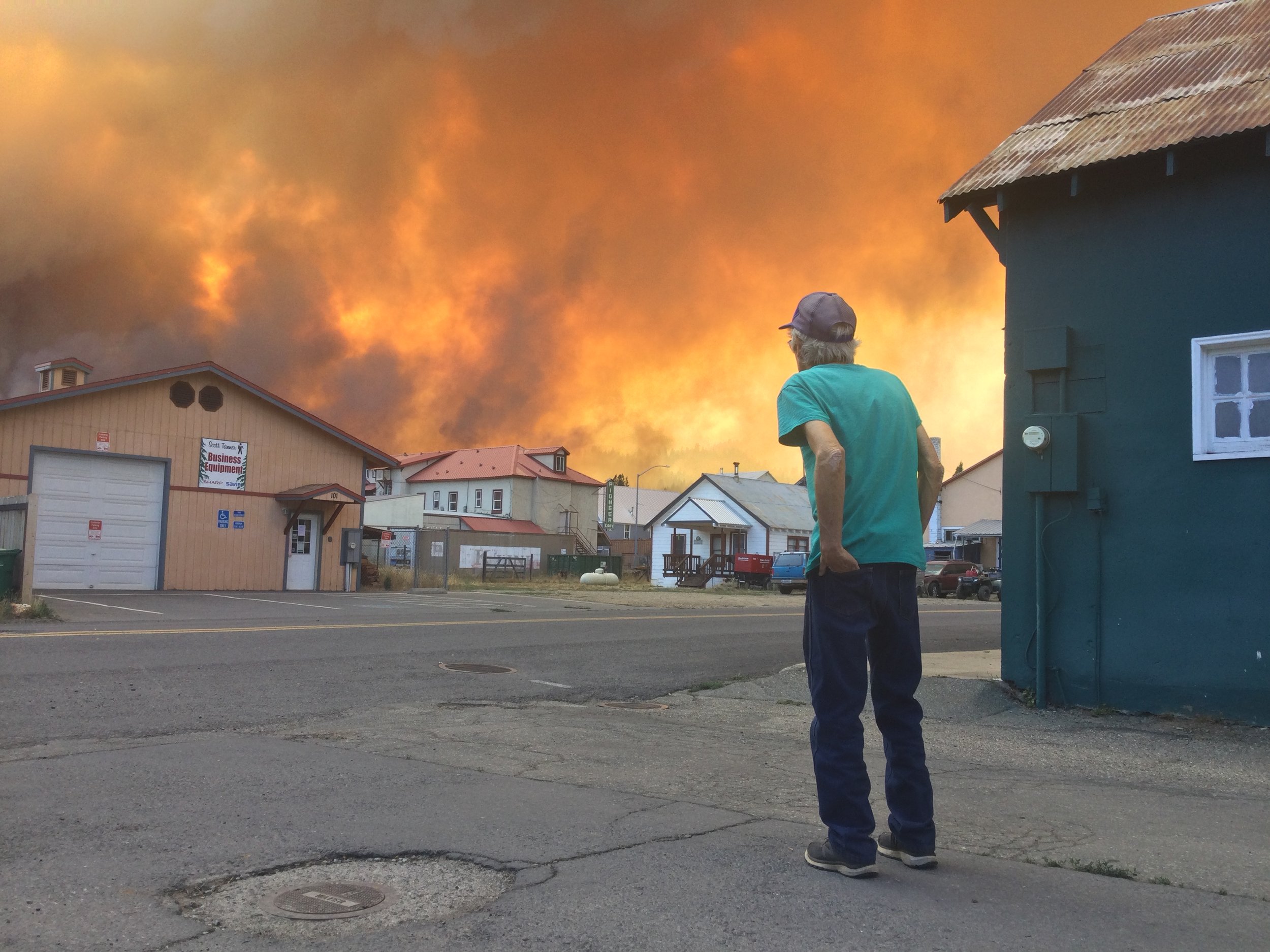
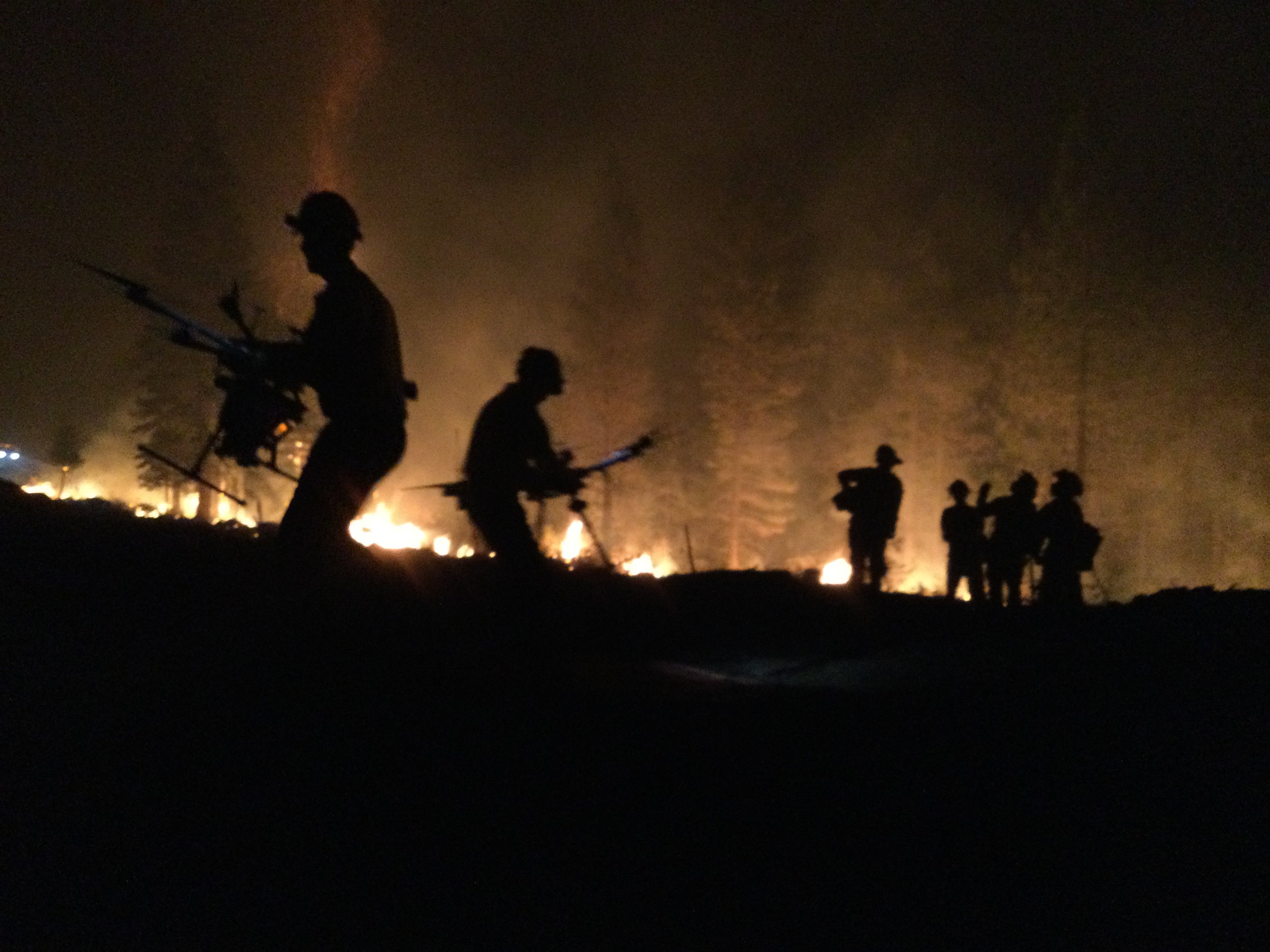
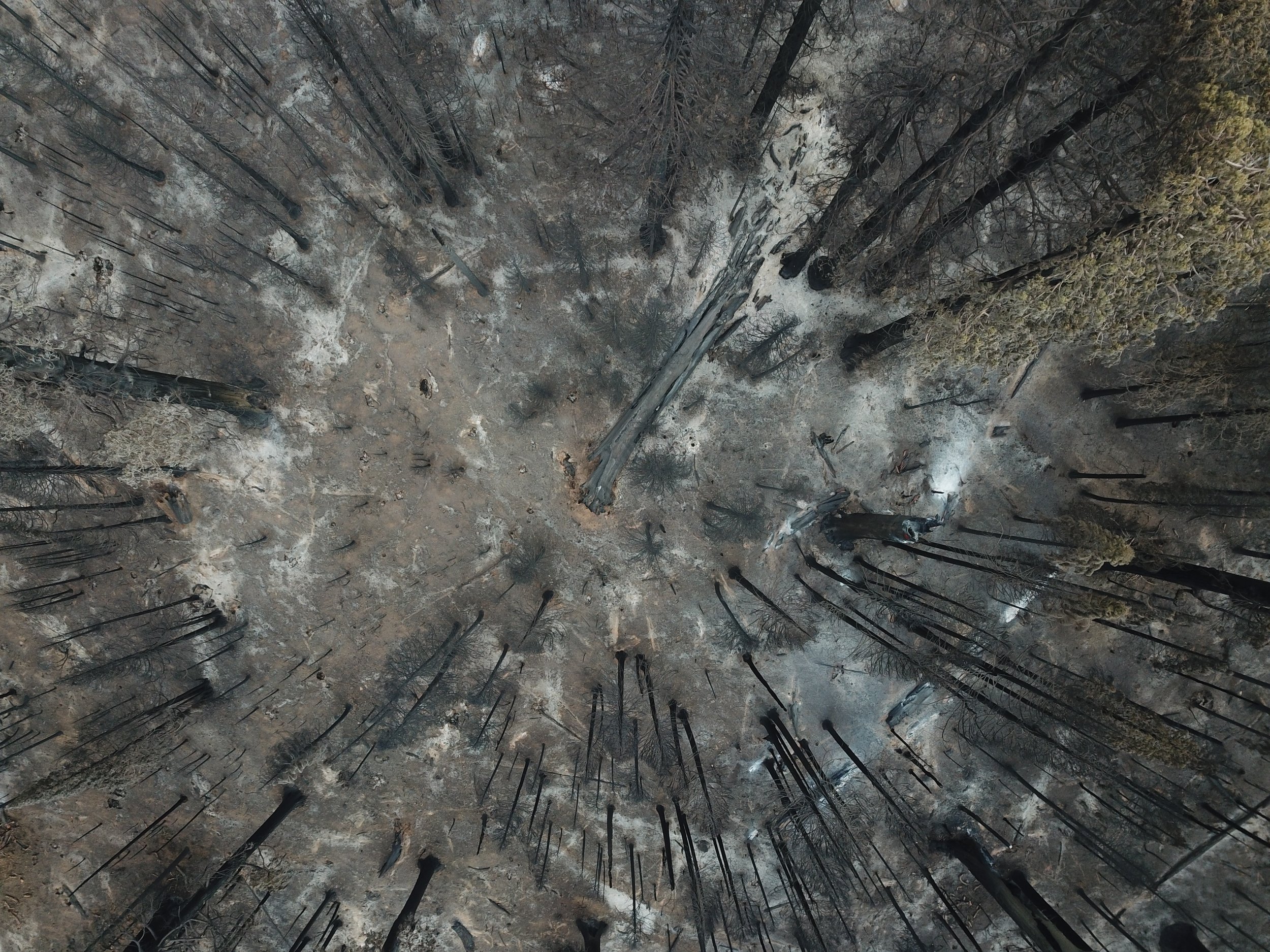
Links from this episode:
This episode features music by: Mepa Melson, Serge Quadrado, Anton Vlasov, LesFM and Coma Media from Pixabay.com
FULL EPISODE TRANSCRIPT:
Sam Prentice 00:06
The Giant Sequoias, visually they're weird. Again, it's surrounded by, you know, the jargon is "a mixed conifer forest", it's just completely stripped of, you know, the beauty of what you're seeing. Just gorgeous diversity of trees, firs, sugar pines that are nowhere near as big as the Giant Sequoias. And so when you're staring into the distance, so to speak, you know, across a ridge, or, or right, I mean, I'm talking to a distance of just a couple 100 feet, you just see trees, everywhere, and then this massive fucking red trunk that is 10 times wider than anything else. And your line of sight doesn't even have any branches on this thing. It's just this red, monolithic beast that rises up like a frickin' photosynthetic volcano. And then you have to like tilt your head back. And that's what they look like when they're alive in these beautiful forests. Well, when you go into a dead forest that has taken out a Sequoia, everything's black. It's hard to answer your question now when I refer back to it without thinking about what they look like when they're dead, dude.
Kris Hampton 01:24
Over 150 years ago, June 30th, 1864, President Abraham Lincoln, embroiled in the midst of the Civil War, signed a landmark piece of legislation. Senate Bill 203 protected a grove of Giant Sequoias in California for, and I quote, "public use, resort and recreation." This marked the first time the federal government had set aside a scenic natural area for future generations. Eight years before Ulysses S. Grant would designate Yellowstone our first national park, and more than two decades before Yosemite would become the third. The Mariposa Grove of Giant Sequoias would be the impetus for what would ultimately become our system of national parks, often called our nation's greatest idea. And that's because these massive trees, some of the oldest and largest living things on the planet, are worth saving. I'm Kris Hampton. And you're listening to Plug Tone Outdoors.
Sam Prentice 02:31
Mariposa Grove, which is the southern part of Yosemite - that's my backyard. We go to Mariposa Grove regularly. Have, have been for the past four years that I've been living there. My name is Sam Prentice. My occupation title is District Hydrologist for the USDA Forest Service. That's the official title. Because of my postfire work, and because of my fire qualifications, and the fact that I am geographically where I'm at, the past three years, I've become a Giant Sequoia mortician of sorts.
Kris Hampton 03:16
I'll be honest, before this conversation, I really didn't know much about the Giant Sequoias, or wildfires for that matter. But the Mariposa Grove was being threatened by the Washburn fire. And when someone talks with the passion and emotion that Sam does, it's hard not to get interested, and there are countless rabbit holes to follow. In one of those rabbit holes, I came across a quote from Yosemite fire information spokesperson, Nancy Philippe, talking about the tree known as the "Grizzly Giant". In an LA Times article she says, "This two to three thousand year old tree has a rich, vast history that goes back to Abraham Lincoln." We can't know the exact age without counting the rings, but just imagine if this estimate is correct. Now standing over 200 feet tall and nearly 100 feet circumference at its base, the Grizzly Giant was likely a sapling at the time that Rome was being founded. It was already 100 feet tall or more when Buddhism started in the fifth century BCE. This tree was fully grown, possibly having already lived 1,000 years when Julius Caesar proposed the 12 month calendar that we still use. So the Grizzly Giant, one of 500 mature Giant Sequoias in the Mariposa Grove, does indeed have a rich, vast history, but it goes much, much deeper than Abraham Lincoln. And we have this tree to thank for the national parks that we get to enjoy today. And frankly, we have ourselves to blame for the fires that are killing these trees.
Sam Prentice 05:05
Yeah, I mean, we're in the Pyrocene, as it is called, you know, it's the fire era in the West. That's undeniable. And I know through my experience, being you know, within, within the fire structures, doing what I have trained, you know, to do in there. We're just not achieving the things that we wish we were achieving. As a matter of saving the resource base for extraction purposes, the Forest Service, back in the early part of the 19th century, set up a policy to extinguish fires from Western landscapes as soon as possible after they started. The primary reason for that was, again, to protect the timber, as it's known, as a forest is called, because it has economic value.
Old-Time Advertisement Audio 06:02
A forest is many things. Shady places where you can camp. Good places for picnics, too! Yes, and a home for wildlife. All kinds of wildlife! Timberland for lumber harvest, and grazing lands, so there'll be meat for dinner. And milk in the morning! Watershed to make sure you'll get water when you turn the tap on at home. A forest is sure a lot of things! Yes, but let a little fire get started, catch on, destroy, and your forest is nothing. Nothing for anybody. You have so many reasons to protect your forests. Remember, only you can prevent forest fires.
Kris Hampton 06:49
I'm sure Smokey had good intentions. But let's face it, that poor bear was misled. Painting forest fires as a scary, destructive thing that needed to be stopped immediately had a whole host of unintended consequences. The highly-flammable underbrush went mostly unchecked, covering forest floors. Hotter summers and heavier wind storms killed and knocked down trees at a record pace. Fire suppression allowed these dead trees and the undergrowth to literally pile up. The people in the fire community simply refer to this as "fuel". Now for many years, Giant Sequoias were thought of as fireproof. And it's true that they've adapted to living through fire - thousands of years of it. The big trees will drop any branches below 70 feet so that fire has a harder time reaching the canopy where the leaves and smaller branches are. Their red hairy bark is sometimes two to three feet thick, acting as an insulator. But they didn't just adapt to fire. They exist because of it. Sequoia cones need the heat from small fires to release their seeds. And fire leaves behind a bare mineral bed of soil that seedlings can thrive in, not to mention killing off the brush that would compete with the Sequoia saplings for resources. So for centuries, they counted on fire - were born from it. Until we stepped in, did exactly what Smokey told us to do, and turned our forest floors into forest fire fuel.
Sam Prentice 08:26
There's so much accumulated material on the ground that when you walk through the landscapes after a fire to approach one of these giant trees which has succumbed, you're literally wading through moguls of ash. You need to do something about it. Nature did something about it. Well, actually, natives primarily did something about it, by managing the landscape over millennia, by keeping fire in the western slope of the Sierra pushing through at a return interval of, you know, two to seven years, it would see fire on any patch of landscape, for millennia. A lot of these landscapes haven't seen fire in 60-70 years - the end result of our over-extraction and the exclusion of fire from the 19th century onward. And then the wars, the environmental side, you know, like war's intention of the latter part of the 19th century led us to still not manage the forests. On top of that, as a species, we have mismanaged the climate. And so in doing, we're injecting a lot more heat. And the way that's playing out in the western part of the US is through aridity and a lot more droughts. To give you a number, my forests - the Sierra National Forest in between Yosemite and Sequoia Kings Canyon - was kind of ground zero because of just the the way the natural geography and weather patterns are. We lost 70% of our productive forest lands.
Kris Hampton 10:00
Wow, really?
Sam Prentice 10:01
Yeah, man. For real.
Kris Hampton 10:03
That's a huge number.
Sam Prentice 10:04
It's over half, right.
Kris Hampton 10:08
So drought kills over half of a productive forest. That leaves behind a lot of fuel, really dry fuel. Add to that our climate crisis and lengthened fire seasons, and we have a disaster waiting to happen. And it did. Between 2015 and 2021, 85% of the acreage in Giant Sequoia groves burned. These fires, fueled by the deadfall from droughts and 100 years of fire suppression, killed more than 20,000 of the large Sequoias - those more than four feet in diameter - and it's still ramping up. The vast majority, over 20% of the total Sequoia population, has died of fire in the last two years alone. And in post-fire analysis, some scientists report seeing only a few dozen seedlings where they'd normally expect to see thousands.
Sam Prentice 11:10
Now having worked in fire a lot, so I've found that there's just a difference between myself and the firefighters I work alongside. Their bread and butter is going to places that they've never seen healthy, for the most part, and dealing with the wildfire, you know, emergency that's, that's happening. So that's, that's what they're used to seeing. Like, oh, they show up, you already got columns in the air, you're already choking on smoke, you're already driving across like, you know, "miles of black", as we call it. And that's just the job.
Sam Prentice 11:40
For me, I can see what it looks like beforehand, because I know a lot of these areas, especially in the western slope of the Sierra. And so now I drive around places that are green, as we call them, meaning they haven't burned yet. And that's what I'm thinking: that they haven't burned yet.
Kris Hampton 12:08
We will be right back.
Emily Holland 12:19
Hey, like what you're hearing? Want to create something like this for your own brand? Plug Tone Audio is a full podcast production studio. We help outdoor brands make engaging, intentional, and unique audio experiences to tell their brand stories. With full capabilities in-house, Plug Tone is a one-stop shop for ideation, production, audio engineering, and distribution of audio storytelling. We are aiming to help tell the stories that aren't being told in our traditional outdoor media. If you want to create something amazing together, go to plugtoneaudio.com and reach out. We can't wait to hear from you.
Kris Hampton 12:58
The Washburn fire that threatened the Mariposa Grove ended up burning 4,886 acres and evacuating 700 people from homes and campgrounds, but ultimately didn't destroy the Giant Sequoias that gave birth to the national parks. However, just two weeks after the Washburn fire began, another fire less than 50 miles away was sparked. The Oak fire was a different story, burning over 19,000 acres, evacuating 6,000 people and destroying 193 structures. What made the two fires so different? Experts say that it was due largely to the management of the landscape. Yosemite, where the Washburn fire began, had acknowledged the importance of cultural burning, a practice started long before the national parks were an idea, and they've recently cleared vegetation and reintroduced fire, 22 prescribed burns happening in the Mariposa Grove alone. Near Midpines where the Oak fire began, fire had been occluded from the landscape for 100 years. And the longer we allow that fuel to build, the harder it gets to remove it.
Sam Prentice 14:26
Landscapes that have had fire run through them naturally are less flammable in the long term, you know, so we want to try to reintroduce "good fire", as it's called, as much and in as many places as possible where it's been excluded historically. But those preconditions, you know, where we actually can set the fire and have the right relative humidity, and the right wind speeds, and the right forecast, and the right distribution of fuel - quote, unquote - to carry the fire usefully through the landscape without it escaping and causing a catastrophic wildfire. Those preconditions are going to get harder and harder to meet. There's no question about that. So, you know, we essentially have a waste disposal problem is what it comes down to. It makes management of reintroduction of fire more complex. The democratic process is messy. It's useful, but when the people who are setting up the plans have lost that social licence - for example, what happened in New Mexico, just this, you know, several months ago, when there was an escaped prescribed burn that burned a half million acres, including homes - it opens up all kinds of wounds, and then you end up trying to negotiate from a trust deficit, you know.
News Broadcaster Voice 16:04
Well, tonight in a Target 7 Investigation, John Cardinale looks at what forest officials knew before deciding to do a prescribed burn at Hermits Peak.
Investigative Journalist Voice 16:11
Last month, a prescribed burn done by the federal government got out of control, sparking the Hermits Peak fire. It grew so large it merged with another fire, becoming the second largest fire in New Mexico history.
Spokesperson 16:25
The US government is responsible, in large part, for this fire.
Kris Hampton 16:36
Studies show that people in rural areas trust the government considerably less than people in urban and suburban areas, and the National Forest Service is part of that government. There's also evidence that minority communities and people of color are disproportionately affected by wildfire, including, ironically, the indigenous communities that have long understood how to better manage our forests. For instance, the creation of Yosemite National Park was made possible in part due to the displacement of the Southern Sierra Miwuk tribe, who were forcibly and violently relocated to the foothills near where the Oak Fire was ignited. Their cultural burning was outlawed. Over the next 100 years, we effectively turned the area into a tinderbox. And in this recent fire, many Miwuk people watched their homes and cultural sites burn. So what reason do they have to trust the government?
Spokesperson 2 16:47
Many of us in the community are very concerned about the circumstances under which they started the prescribed burn.
News Broadcaster Voice 2 17:38
In today's cover story, ABC 10's lead Race and Culture reporter, Kandace Redd, shows us how wildfires have an unequal impact on minority communities.
Reporter Voice 17:47
A 2018 study shows mostly black, Hispanic or Native American communities experienced greater vulnerability to wildfires compared with primarily white communities in the US. Researchers at the University of Washington and the Nature Conservancy looked at more than 70,000 communities across the nation. Based on the data, the majority of people at risk were white and not poor, but about 12 million others were considered more vulnerable to wildfires based on socio-economic factors, including minorities, people with disabilities and people living in poverty.
News Investigation Interviewee Voice 18:20
How much money do they have? Do they have access to information? What sort of transportation and housing assets do they have?
Reporter Voice 18:28
Researchers also found Native Americans are six times more likely than others to live in areas most prone to wildfires.
News Investigation Interviewee 2 18:35
Forced removal, lack of resources, and that history, I think, is one of the biggest concerns for me.
News Investigation Interviewee 3 18:42
These disparities that we see now are likely just going to get bigger and bigger with climate change. So we need to create these systems, where we're both feeding the health of the ecosystem and feeding the wealth of the community.
Kris Hampton 18:58
In our outdoor recreation communities, we often dream about that house out of town, on property that backs up to BLM, or forest service, or park land that will never be developed. We don't often think about how that puts us in harm's way. And we almost never consider the fact that we're building homes in a place that makes fire management more difficult, which then threatens not only our forests and natural icons like the Sequoias, but also the communities who have existed in tandem with these natural landscapes for all of recorded history.
Kris Hampton 19:02
Would you say that - and maybe this is the wrong word, I'm just curious your reaction to this word - would you say that those homes that are out in the like foothills, away from town, are in the way of fire management?
Sam Prentice 19:59
Is San Francisco in the way of earthquakes? We're humans, man.
Kris Hampton 20:07
Yeah, yeah. Okay.
Sam Prentice 20:08
You know, people in our community, people who we know who want their slice of the Western dream, and it's in a rural area? Yeah, absolutely, it complicates the planning process. A: you don't necessarily want heavy equipment tracking around trying to pull all this excess vegetation out because the vegetation is beautiful sagebrush, you know, backed by gorgeous Pinyon Juniper, which flanks up to beautiful slopes of conifers, which top out on the alpine peaks that you just have, you know, climbed like four times because it's in your backyard. And then if your local municipality gets into the conversation about trying to reintroduce fire, because your property maybe backs up to forest service land, your ears are gonna be perked up about that. From a planning perspective, me as a technocrat, you know, I put on that hat and like, "Well, it increases the complexity of the planning process, because we have to manage for, you know, the individual property ownership. And this property is accessed by a Forest Service road, but it's partially owned by the utility company and blah, blah, blah." This is the, you know, this is the stuff that I deal with, right? But we're humans, so we either shrug it off, or we rely on the larger economic structure of society to subsidize our presence there. And in this case, it's the insurance companies. Can you get homeowners insurance in a fire-prone location? 10 years ago, that wasn't even really like a question. But now, it's absolutely on the table. Insurance companies have gone under. For example, the Camp Fire that took out Paradise, California, which is, man, if there's a poster child for what the climate change era will do, in terms of socio-economic disruption, it's what happened in Paradise.
Kris Hampton 22:01
In the early morning hours of November 8th, 2018, a wildfire roared through the town of Paradise, California, killing 86 people and destroying nearly 19,000 buildings, businesses and homes. This is Butte County Sheriff and Coroner, Kory Honea, from a 60 Minutes report:
Kory Honea 22:20
I think the best way that I can characterize it is it was out running us before we even knew we were in a race or what direction the race was going to take us. It was dark, it seemed like it was nighttime because the smoke had blocked out the sun. Ash and embers were raining down. And as the fire grew closer, there was this real sense of it being hell on earth.
Radio Controller Voice 22:44
Mandatory evacuations: all of Paradise. Get people moving now!
Kory Honea 22:50
On the morning of November 8th, there was a thriving community and in a matter of hours, it's wiped out, it's gone.
Kris Hampton 23:00
Confusingly called the Camp Fire, the wildfire that destroyed Paradise was actually started by a neglected piece of Pacific Gas & Electric equipment on a nearby transmission tower. PG&E would later go bankrupt to plead guilty to 84 counts of involuntary manslaughter and be ordered to pay 11 billion dollars of the 20 billion insurance companies sued them for. And many of those payouts are still held up by red tape and bankrupt insurance companies rather than making it to the homeowners who are in need. Now, insurance companies, the media, and most of us, categorize wildfires as natural disasters. But over 80% of wildfires are caused by humans. Actual camp fires are only 5% of those, cigarette butts even less. And if we start counting our role in climate change and how it exacerbates the less than 10% of fires caused by lightning, then our role becomes even larger. So what can we do? Is it possible to reverse the damage we've done? More on that after this.
Kris Hampton 24:34
So what is the Plug Tone Audio Collective? Well, first and foremost, we're a diverse group of the best, most impactful podcasts in the outdoor industry. We're a network of creative, passionate, forward-thinking people who believe in the transformative power of storytelling and service to our communities through podcasting. Climbing, hiking, skiing, mountain biking and expanding outward. We're here to offer effective advice, ask great questions, and tell the stories that aren't being told. You can listen, follow along, and learn more about us and our shows on Instagram @plugtoneaudio, or on our website at plugtoneaudio.com. And please subscribe to the show, give us a rating, leave us a review, and share this episode with a friend. It really helps.
Sam Prentice 25:58
Currently hiking off trail in an elder Grove of Giant Sequoias in the southern Sierra. Beautiful place. It's really suffering from tsunamis of wildfires, we lost about 20-25 of them out of this 70 or 80 that we have here, to a high-intensity fire which should never have happened. And the objective here today is to get to a high point, fly a drone, collect some aerial imagery that can be used to help us get in here and clear out some of the undergrowth in these Sequoias so we can get fire back into them. We've excluded fire for so long that if we put fire in them right now, reintroduced it, bad things would happen. Congress - in a good way: bipartisan - has passed a "Save Our Sequoias Act" emergency declaration, targeting 20 groves across two national forests for thinning small trees and underbrush. So that way we can get back in there. It's good work. It's work that we desperately need. First, got to get up to this, this high point.
Kris Hampton 27:25
The "Save Our Sequoias" or SOS Act was recently introduced by a bipartisan group of congressmen in California. It recognizes the emergency situation, and aims to fast track projects that would normally require years of wading through bureaucratic red tape, mainly the removal of so-called fuels. Environmental groups like "Save the Redwoods" and "The Nature Conservancy" have shown up in support. But not everyone agrees. More than 80 groups have sent letters to Congress in opposition of the legislation, including the "Sierra Club" and "Earth Justice". These groups lay the blame squarely on climate change and accuse this act of merely tackling a symptom of the real problem. And it's the provision to fast track the projects, skipping the normal environmental assessments and impact statements, as well as the consultation process required under the Endangered Species Act, that seems to be the big deal breaker. So the red tape is there for a reason, a good reason. But red tape requires time to work through, time we may not have. So we have to weigh the sides, each of us individually. I'm not going to try to tell you which side to be on. What I will say is that, like any other issue that's bound by legislation and political decision making, one of our best options is to vote - on the local level, as well as the national level - and consider donating to the groups whose mission aligns with your beliefs. The cost of fighting fires makes up over half of the Forest Service budget every year, and is expected to increase. And I mean, ultimately, both sides of this issue have the same goal: Save homes, save lives, save our Sequoias.
Sam Prentice 27:25
If you're sitting there listening to this podcast, there's a pretty good chance that you either have disposable income right now or you're going to have it in the future. And so develop a practice of donating because it really does matter. You know, it matters to people in Paradise. It matters to people in Greenville. You know, it matters to towns that have, you know, lost their home and you know, are becoming displaced climate refugees. We're bearing witness to change. And if that change is not on you right now, if it's not affecting your pocketbook, if it's not affecting your like, "I have to plan around this, I have to box my possessions up every year, and rent storage because I got a cedar shake roof that is likely to burn down," that sort of lifestyle maintenance comes at a cost. If you're not feeling that cost right now, that's great. But understand that that's what climate change is going to look like. And that's what it already does look like for a lot of people.
Kris Hampton 30:07
On the personal level, in our own lives, we can do much more than just putting out our campfires. 40,000 wildfires are started by humans every year. I don't have data to back up this statement, but I'm guessing most of them thought they were pretty good, responsible people. So we can all drop the "it can't happen to me" attitude that so many of us carry. Many fires are started by sparks from vehicles and equipment that haven't had proper maintenance or are parked on dry grass. A typical car exhaust can reach up to 500 degrees. In drought conditions, stay on the designated roads and pay attention to the conditions. Know when you're traveling to an area currently affected by drought and take the necessary precautions - maybe not even going if that's the best decision. And actually, Smokey Bear has wisened up as well. The website smokeybear.com is a great resource with prevention tips beyond the commercials you remember as a kid, things like proper ways to burn debris, use and maintenance of equipment, how to prepare your home for wildfire if you're in a risk area, as well as educational tools available to teachers and parents. And Smokey has a few high-profile friends helping him spread the word about the ways we can help prevent wildfires.
Betty White 32:08
Honorary Forest Ranger, Betty White here, lending a hand to my dear friend Smokey Bear because for years he's only said, "Only you can prevent wildfires." But there's a lot more to say. Like if you park your car on tall dry grass, the hot exhaust pipe can start a wildfire. So keep the animals safe, especially the cute shirtless one. Go to smokeybear.com to learn more about wildfire prevention.
Kris Hampton 32:37
Thanks to Sam Prentice for sharing his passion for saving the iconic landscapes that are the literal foundation of this country. In your show notes you'll find links to resources for wildfire prevention and where to donate to help save the Sequoias. You'll also find a link to our website where we've got a full transcript of this episode, photos of Sam at work in the field, and some photos he's taken of these majestic Sequoia groves. And while you're there, check out the rest of the shows in the Plug Tone Audio Collective, a group of the best most impactful podcasts in the outdoor industry. And please share this episode with your friends who spend time outdoors. It helps us out and it helps our natural landscapes survive. I'm Kris Hampton, you've been listening to Plug Tone Outdoors.


